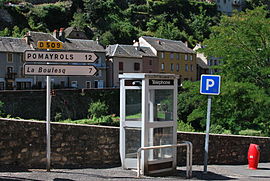You can help expand this article with text translated from the corresponding article in French. (January 2019) Click [show] for important translation instructions.
|
Saint-Laurent-d'Olt (French pronunciation: [sɛ̃ loʁɑ̃ dɔlt], literally Saint-Laurent of Olt; Occitan: Sant Laurenç d'Òlt) is a commune in the Aveyron department in southern France.
Saint-Laurent-d'Olt | |
|---|---|
 Street furniture in Saint-Laurent-d'Olt | |
| Coordinates: 44°26′49″N 3°06′42″E / 44.4469°N 3.1117°E | |
| Country | France |
| Region | Occitania |
| Department | Aveyron |
| Arrondissement | Rodez |
| Canton | Tarn et Causses |
| Government | |
| • Mayor (2020–2026) | Alain Vioulac[1] |
Area 1 | 38.74 km2 (14.96 sq mi) |
| Population (2021)[2] | 639 |
| • Density | 16/km2 (43/sq mi) |
| Time zone | UTC+01:00 (CET) |
| • Summer (DST) | UTC+02:00 (CEST) |
| INSEE/Postal code | 12237 /12560 |
| Elevation | 448–1,033 m (1,470–3,389 ft) (avg. 545 m or 1,788 ft) |
| 1 French Land Register data, which excludes lakes, ponds, glaciers > 1 km2 (0.386 sq mi or 247 acres) and river estuaries. | |
Geography
editSituated on the D988 departmental road, roughly equidistant between the towns of Millau, Rodez and Mende, and 3.5 km west of the A75 autoroute, Saint-Laurent-d'Olt is perched on a rocky ridge above the river Lot, at about 584 metres above sea level. The upper valley of the Lot divides the volcanic plateau of the Aubrac from the limestone plateaux of the Grands Causses.
In order to preserve the biodiversity of the area, the upper Lot valley between Espalion and Saint-Laurent-d'Olt is gazetted as part of the Natura 2000 network.
The commune is also part of the Parc naturel régional des Grands Causses.
Institut Médico-Educatif (I.M.E.)
editAs well as providing services for the surrounding district, the village is home to an Institut Médico-Educatif, which is a residential school for children with intellectual handicaps, aged 6–20. The current roll is around 80 pupils. Founded in 1965, the Institut is the largest employer in the commune, employing 60 people.[3]
Population
edit| Year | Pop. | ±% |
|---|---|---|
| 1962 | 731 | — |
| 1968 | 745 | +1.9% |
| 1975 | 728 | −2.3% |
| 1982 | 658 | −9.6% |
| 1990 | 659 | +0.2% |
| 1999 | 619 | −6.1% |
| 2008 | 661 | +6.8% |
See also
editReferences
edit- ^ "Répertoire national des élus: les maires". data.gouv.fr, Plateforme ouverte des données publiques françaises (in French). 2 December 2020.
- ^ "Populations légales 2021" (in French). The National Institute of Statistics and Economic Studies. 28 December 2023.
- ^ "Enfance et jeunesse".
External links
edit



